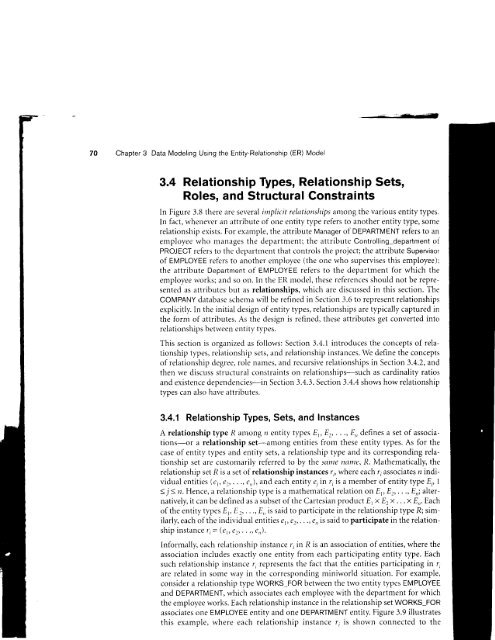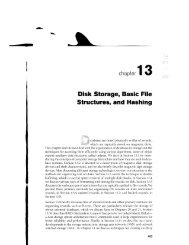this pdf excerpt
this pdf excerpt
this pdf excerpt
Create successful ePaper yourself
Turn your PDF publications into a flip-book with our unique Google optimized e-Paper software.
Chapter 3 Data Modeling Using the Entity-Relationship (ER) Model<br />
3.4 Relationship Types, Relationship Sets,<br />
Roles, and Structural Constraints<br />
In Figure 3.8 there are several irnplicit relationships an-lol-rg the varrious entity types.<br />
In fact, whenever an attribute of one entity type refers to another entitv type, some<br />
relationship exists. For example, the attribute Manager of DEPARTMENT refers to an<br />
employee who manirges the department; the attribute Controlling-department oi<br />
PROJECT refers to the departn-rer.rt that controls the project; the attribute Supervisor<br />
of EMPLOYEE refers to another employee (the one who supervises <strong>this</strong> employee);<br />
the attribute Department of EMPLOYEE refers to the department for which the<br />
employee rvorks; and so or.r. In the ER moclel, these references should not be represented<br />
as attributes but as relationships, which are discussed in <strong>this</strong> section. The<br />
COMPANY databa-se scher.na will be refined in Section 3.6 to represent relationships<br />
explicitly. In the initial design of entity types, relationships are typically captured in<br />
the tbrm of attributes. As the design is retined, these attributes get converted into<br />
relationships between entity types.<br />
This section is organized as fbllows: Section 3.4.1 introduces the concepts of relationship<br />
types, relationship sets, and relationship instances. We define the concepts<br />
of relationship degree, role narnes, and recursive relationships in Section 3.4.2, and<br />
then we discuss structural constraints on relationships-such as cardinality ratios<br />
and existence dependencies-in Section 3.4.3. Section 3,4.4 shows how relationship<br />
types can also have attribr,rtes.<br />
3.4.1 Relationship Types, Sets, and Instances<br />
A relationship type R an'rong n entity types E', E2, . . ., E,, defines a set of associations-or<br />
a relationship set-among entities from these entity types. As for the<br />
case of entity types and entity sets, a relationship type and its corresponding relationship<br />
set are customarily referred to by the same neme, R. Mathematically, the<br />
relationship set R is a set oI relationship instances r;, where each r, associates n individual<br />
entities (ep e1, .. ., c,,), and each entity e, in r; is a member of entity type E', I<br />
3 j! n. Hence, a relationship type is a mathematical relation on E1, E2, . . ., Er; alternatively,<br />
it can be deflned as a subset of the Cartesian product E, x Erx . . . x E,,. Each<br />
of the entity types E1, E ., . . ., E,, is said to participate in the relationship type R; similarly,<br />
each of tl-re individual entities €D e,,. .., e,, is said to participate in the relationship<br />
instarnce r;= (ey, e., . . ., e,,).<br />
Informally, each relationship instance r; in R is an association of entities, where the<br />
association includes exactly one entity from each participating entity type. Each<br />
such rel:.rtionship instance r, represents the fact that the entities participating in r'<br />
are related in some way in the corresponding miniworld situation. For example,<br />
consider a relationship type WORKS-FOR between the two entity types EMPLOYEE<br />
and DEPARTMENT, rvhich associates each employee with the department for which<br />
the employee works. Each relationship instance in the relationship set WORKS-FOR<br />
associates one EMPLOYEE entity and one DEPARTMENT entity. Figure 3.9 illustrates<br />
<strong>this</strong> example, where each relationship instance r; is shown connected to the














